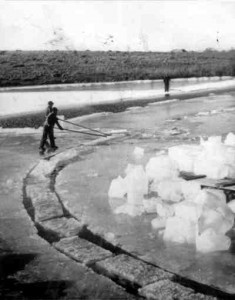Column by John Mattingly
Economy – December 2008 – Colorado Central Magazine
WE’VE HEARD A LOT lately about Wall Street and Main Street, about the financial economy and the “real economy.” The news has been filled with the worries of PLOPs (People Living On Pavement).
Very little, however, has been said about those of us who don’t live on a street, whose address is on a county road or star route and whose livelihood comes from dirt.
While it’s true the U.S. economy is inter-dependent in ways that blur all these “street” distinctions, those living on dirt roads are doing OK, so far. And I’m not referring only to those survivalist sorts who hunt their meat, grow their food, and have a cave full of beans and bullets. The agricultural sector, which I’ll characterize here as the Dirt Road Economy, is healthy. Commodity prices are still in historically high quadrants, even after falling recently from stratospheric speculation (a market moment that provided producers with an unprecedented economic opportunity). Farms are not being foreclosed upon in any big way, farm machinery is not being repossessed at an unusual pace, and not only are there no job losses in the Dirt Road Economy, ag jobs are waiting to be filled all over the United States. But unlike some Wall Street positions, none of the ag jobs include the prospect of a multi-million dollar bonus for engineering a crop failure.
The key here is the ag sector went through a credit adjustment bloodbath, aka de-levering, over 20 years ago and, for the most part, learned collective, enduring lessons about how best to regulate ag debt. In the late 1970s, farmland values increased in the U.S. due to upward spikes in commodity prices and easy credit. Some insurance companies were so eager to lend to the ag sector that the joke was: “If you can fog a mirror, you can borrow a million; for ten million you gotta fill out an app.” Among the more conservative ag lenders, underwriting standards primarily emphasized character and collateral, nicknamed in the trade the “Two Cs.”
“In those days it was pretty much a good ol’ boy standard,” said Ken Sears, head of the Farm Credit Services in Monte Vista. “If the person was known to be a good farmer and the farm was a good one, the loan was made, without much attention given to the repayment plan, or if the borrower was strong enough financially to withstand a downturn.”
That all changed in the early ’80s when commodity prices veered into the ditch, interest rates skyrocketed, foreclosure and repossession rates jumped, and many ag banks and rural COOPs failed. The ag economy entered a crash-n-burn recession, farmland values dropping as much as 60%.
FROM THE ASHES came tighter underwriting standards for ag loans, perhaps the most significant being a shift from lending based on the Two Cs, to lending based on income and financial strength. “It was a four-legged stool of: income, balance sheet, collateral and character,” Sears said. “Our auditors came in and told us how it was going to be, though I don’t recall any special legislation or bailout like we’re seeing with Wall Street today. The change was driven by common sense.” The “Two Cs” became the back two legs of the “stool’ because if the worse case came along, the bank didn’t want the farm any more than they wanted to repossess the borrower. In some cases during the early ’80s, the banks didn’t want any more farms, as plenty of farmers had already presented their loan officers with the gate keys. The bank wanted only a reasonable slice of the annual productivity from a farm, so basing the loan solely on the farm real estate made no sense.
This was often confusing and/or frustrating to many farmers during the adjustment period. I recall neighbors angrily saying things like, “My farm is worth a million bucks and I can’t borrow a hundred grand.” Or, “I got the tractor loan, but had to put up so much collateral I thought they were going to ask for my first-born.”
When it came to ag loans for real estate purchases, the revenue-for-repayment requirement remained primary, and then, a secondary level of scrutiny followed: a solid loan-to-value ratio confirmed by appraisal, usually 85% or less — that is, a maximum of 85-cents, and more typically 65-cents, could be loaned for every appraisal-confirmed dollar of farm value. Unlike many of the home and consumer loans made at 100% to 125% of value, ag lenders became conservatively positioned to withstand occasional downturns.
TRANSLATION: ag lenders did not factor potential appreciation of farmland assets into their loan metrics, which means that in valuing their loan portfolios, they didn’t have to worry about the mark-to-market or mark-to-myth confusion that now shares responsibility for “freezing” credit between banks, and banks and borrowers. For ag lenders, mark-to-maturity has a high probability of yielding an accurate picture.
In ag lending, revenue projections are knotted tightly to historical performance verified by tax returns, integrity and honesty weighing heavily in the balance. While this makes it difficult for young, start-up farmers to enter the field (impossible, some would say), it also increases the chances that sustainable, well-capitalized operators make it.
Perhaps most important, the Dirt Road Economy remained in the business of creating new wealth, of making real things, producing food, fiber, and raw materials. Wall Street and Main Street, on the other hand, became distracted by the profit potential in merely shuffling paper (finance and derivatives) and lost their competitive edge in manufacturing. General Motors, for example, yanked over half its revenue from its financing branch, GMAC, in 2007, which explains why offering to pay cash for a vehicle at the car dealership isn’t met with a quick handshake.
Major U.S. manufacturing firms became content to merely finance their products, even when those products were manufactured outside the U.S., and this contributed further to their lack of competitiveness in the task of actually making things. U.S. farmers, meanwhile, had no choice in the ’80s but to get competitive with the new world markets and stay that way, which was what the decline in commodity prices was really all about. Farmers had to take the field knowing they were competing with a European farmer, a Chinese gardener, and a cane cutter in a loin cloth in South America. There was no way to out-source a crop and carry a promissory note on the harvest.
And finally, ag producers didn’t get greedy. No big bonuses were given to growers who increased productivity every year, even though ag productivity has increased steadily (about 2% per year) since 1948 when such analytic records commenced. There aren’t a lot of shareholders in the Dirt Road Economy demanding growth at any price, or packs of predatory pundits making estimates of earnings that stimulate absurd creativities in accounting. While farmers may exaggerate their yields at the coffee shop, there’s a tight lid on how much even the best liar can get away with. One consequence of this absence of greed is that the Dirt Road Economy has remained relatively competitive in world markets, despite all the irregularities of “free trade”.
Of course, just because the Dirt Road Economy is still strong, doesn’t mean it will drive by the wreck at Wall and Main without slowing down.
“This (credit crisis) will hurt us, in that it could increase our cost of funds,” Ken Sears of Farm Credit Services pointed out. “Even the A-plus, gold-plated borrowers are probably going to feel it. We didn’t get involved in all the ridiculous competition to make bad loans, and neither did most of the local banks. We’d seen all this before. Ironically, a lot of the over-levered problem is driven by the virtue of competition. One bank is out there making crazy loans, getting business, and the bank next door hears about it and doesn’t want to be left out. You have a lot of banks now, which means a lot of competition, which means more opportunity for a lot of bad loans. But we stayed out of it, even though we’ll no doubt be impacted by it.”
Too, there are instances where ag vendors are already trying to hand off their credit problems. For example, fertilizer is so tight that suppliers can demand payment in full six to eight months in advance of delivery, effectively forcing farmers to go to the bank to borrow the money to cover the cost of carry, a function traditionally burdened by the vendors.
The same dynamic hits agriculture from the other direction with the escalating cost of energy, from diesel in the tractor for ground work to the shipping and handling of the harvest. Because the ag sector is at the beginning of the food chain, and because ag producers aren’t unionized or even somewhat unified, it’s hard for them to pass on increases in the cost of energy to the middlemen. Fuel prices have dropped recently, which helps, but it’s almost impossible for farmers to pass on any of the cost increases they encounter in their operating program. One real future hazard for the Dirt Road Economy is a shrinking profit margin despite high commodity prices.
The demand for the basic commodities coming out of the Dirt Road Economy, the stuff of which our daily bread is baked, trades in what economists call “inelastic demand,” which means we all have to eat and therefore we will pay whatever it takes. Some say this will give the ag sector security and prominence in the current recession. But readers of this column will understand from prior segments offered under this byline that the “real economy” has a proven ability to force the ag sector to produce cheap food, farmers taking the difference out of the dirt. And dirt still has a lot of untapped capacity. After all, who could have predicted four billion years ago that dirt would eventually rise up and write articles.
John Mattingly, last spotted somewhere between Creede and Boulder, is a recovering farmer.


